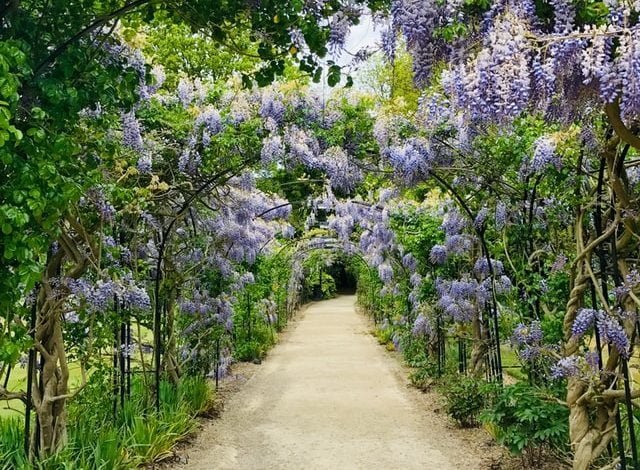Garden Ideas: 22 Outdoor Designs

Garden Ideas: 22 Outdoor Designs
Garden ideas can include everything from a quick upgrade, like painting an architectural feature in a bold new color, to a more thoughtful large-scale project, like remodeling a space or adding a balcony.
Today, patios, backyards, porches, and patios are our favorite spaces. They have the power to create the peace, purpose, and joy we all need in our lives.
So, if you are looking for garden design ideas and inspiration for your outdoor space, there is nothing wrong with choosing the best garden ideas for any size or shape of space.
Best Garden Ideas 2021
1. Make an offer
Designing a landscape that you can enjoy one step away from your property is at the top of your wish list of garden ideas. Think about how outdoor fun spaces can flow with smart seating and patio ideas.
In this renovation of the five-acre site, the center of the design is the large patio area that runs through the house allowing direct views from the kitchen and living room across the colorful border to the lake and wild meadows beyond.
2. Designed with water in mind
Water is a wonderful element to incorporate into outdoor spaces. Not only will it attract wildlife, but the sights and sounds can be very relaxing especially in a city scenario.
“The impressive size of this antique limestone basin adds immediate significance to this city park,” says park designer Peter Wakefield. “This creates a sense of drama effortlessly while providing a focal point for the home’s substantial side elevation.”
Frame a tub like this with a mix of white climbing flowers, pale pink, and Jasmin Trachelospermum fir.
3. Divide the yard with a large fence
“Large grass can feel aimless,” says designer Charlotte Rowe. Dividing the space into garden spaces will ensure that the green space serves a different purpose, such as a balcony area for eating or a patch for growing vegetables.
In this project, the rethinking of the 600 square meter garden resulted in two square lawns, antler beams and a striped antler beam tree.
Charlotte Rowe added, “An enclosed central fence beautifully divides the garden, but also allows views of a shady part of the garden where the owner raised a garden bed with vegetables and salad and a cottage in the garden.”
Dim lighting makes the garden appear nocturnal – the main tree and hornbeams are lit while Cor-Ten steel columns with a rusty finish create low-key lighting along the gravel path.
This is one of many backyard landscaping ideas for a larger garden.
4. Create presence and proportion
In large open spaces, this is one of those garden ideas where it is possible to create interest and intrigue through symmetry and symmetry at scale. The classic Georgian house in this project, designed by Jo Alderson Phillips and Rob Jones, required a garden of equal presence and proportion and was built on the site of an abandoned tennis court.
“The anchor here is a series of yew domes that run through each color of the garden in coordination with the owner’s statue to create a beautiful line of landscape,” the designers said. We bought topiary, which weigh two tons each, at Solitaire in Belgium, a nursery that specializes in these very mature specimens.
Attractive fences and walkways are planted around the garden with Ilex crenata ‘Dark Green’ (Japanese box) and more skeletal cypress trees provided by Pinus sylvestris trimmed with the scent of osmanthus that gives off its year-end fragrance.
5. Path setting
Whatever the shape or size of your garden, there will definitely be a path from the back door to the end of your garden. Consider function as well as aesthetics when looking at garden path ideas and determining the line or curve of your path.
In this Charlotte Roe-designed garden, at the end of the garden, a spot of Lavandula angustifolia “Munstead” freshens the air along the driveway, providing summer nectar for bees. There are small, chunky wooden benches on the other side and in the shade of the mature trees in the garden to create a place to sit and enjoy the garden.
6. Fireplace installation
Whatever the season or climate, a permanent outdoor fireplace is the focal point of the design as well as a source of heat for the cooler times of the day.
According to Focus fireplace expert Guillaume Malaise, the Miofocus (shown), like all outdoor models, must be installed under a sheltered area and located at least 10 kilometers from the coast. The exhaust outlet of the chimney must also be connected with a hood.
Keep in mind that these types of fireplaces require special installation and find and use a high-quality, built-in outdoor fireplace that can withstand weather conditions all year round.
Our favorite pool idea is similar to that of the room above – where the pool is another area of the garden design, rather than a separate space with walls – although safety is always an issue for young children.
7. Be bold with color
Color is an exciting novelty for garden ideas. In classic gardens, it is often the norm to paint exterior details a harmonious color to blend in with the surroundings, but a noteworthy exterior paint formula means we can paint architectural features, such as columns, garden walls, and screens of all kinds of colour. .
“We loved the idea of adding a unique cluster to create a Mediterranean feel among the dark green foliage,” says Ruth Muttersed, Creative Director of Little Greene.
Pair ultra blue paint like ‘Marine Blue’ on the architectural details and columns with a touch of bright yellow sun using Mr. David’s plant pots.
8. Make a night garden
Good outdoor lighting ideas are the key to creating the perfect outdoor environment and adding a certain feel to social events. Carefully chosen, it soaks everything in a warm glow while adding a touch of glam to your evening.
“Garland lights are a classic way to create a festive atmosphere at night—small ceiling lights that bring people together,” says Coralie Claes, managing director at Vincent Sheppard.
These “Light My Table” string lights can be clipped to the side of the table and do not need to be attached to anything nearby.
9. Be a fun statue
When decorating a garden with additional decorations such as sculptures, consider the surrounding environment and the impact of your garden decorating ideas on the design choice and overall space.
“Decorative elements can blend in with their surroundings in tone, texture, and shape, or in fact, create stunning contrasts,” says sculptor David Harper.
“For example, a bright, bold piece of reflective metal will reflect its immediate surroundings and effectively borrow character and charm from the surrounding farmhouse and landscape.”
10. Take the tiles from the inside out
Incorporating patterned tiles into an exterior scheme can make the transition from home to garden. This can be especially effective if the same tiles are used inside and out to create smooth lines from the inside out.
“Decorative tiles also work well in small gardens, and can help define areas,” says Lee Thornley, founder of Bert and May.
Place them on floors and walls to create interesting features or outdoor spaces – this works especially well if you’re looking for outdoor kitchen ideas that require a natural transition between indoor and outdoor spaces.
11. Use the screen to select an area
Garden screens are one garden idea that is a great way to create a little paradise. Great for privacy in the garden from neighbors and some long distance escape with Moroccan inspired decor.
“Be creative with the screens you use, and use them to divide large areas of your outdoor space to create specific relaxation areas,” says Sophie Burkert, founder of Screen with Envy. “The year 2021 sees the house become multifunctional and can be expanded into a garden, with different divided areas dedicated to different activities.”
How about a special rest area for children and a special rest area for adults?
12. Choose furniture to make it last longer
When buying garden furniture, it is important to think about maximizing its use. Check out the comfort-focused setting that will set the scene for a slow lunch, or a smart chair that adds a little sparkle to cocktail hour.
“A space filled with the sun is ideal for outdoor entertaining, so choose light furniture that you can move the seats around for the best lighting,” says Barlow Tyrie.
A tall table with raised legs will create an elegant sense of elevation over time, and a raised viewing point greatly enhances your view of the garden and surroundings.
13. Planting Long Borders
The secret behind Long Frontier’s success is all-season cultivation. In the bright flower garden idea above, Mandy Buckland of Greencube planted a mix of violet, white, and pink.
“The basic structure includes the Taxus Dome and Madame Emile Molier’s hydrangea, but in June, it’s time for the herbaceous perennials to inject some color,” Mandy says.
I planted Nepeta ‘Walkers Low’ with ‘Caradonna’ salvia with Foxglove seed added to provide vertical height as well as ‘Mount Evereste’ Allium. ‘Roseanne’ geranium covers the soil and keeps weeds away, plugging gaps in the mix, and planting a variable texture throughout the seasons. Here’s an ornamental grass Pennisetum along with Hydrangea to move the border in fall.
Remember to add height and contrast to the background. Mandy Buckland included a standard Nellie R Stevens Ilex tree to add interest to the beech fence backdrop.
14. Addition of fire pit area
A moving heat source in the garden means we can stay outside longer and slowly, whatever the season. Choose from fire pits, chimneys and bowls.
“I have a campfire in my garden that can also be used as a barbecue, and we enjoy many evenings outside by the fireplace and keep us warm at the same time,” says designer Sarah Vanrenen.
Create a space in your outdoor space that feels like an outdoor living room or a cozy corner.
“Sometimes a yard can be daunting because there are no set walls or standards, so I often treat the garden as I do at home, creating a ‘room’ and dividing it with plantings to create a distinct and interesting area for entry and occupation,” Sarah added.
15. Make your garden bee-friendly
Any garden, regardless of size, can be bee-friendly and beautiful. Bees, like us, prefer flowers with abundant open flowers and a long flowering season.
“Bees hunt pollen and nectar, and abundant examples include geraniums, lavender, open dahlias, and thistles,” said Sean McMenime, director of Ark Wildlife . “Aside from herbs like marjoram, sage, and chives, flowering shrubs like Buddha, cotton, and apple blossom. “
Why not build a bee nectar filling station? It is just a bowl or bowl full of the nectar that gives flowers and a shallow dish of water (bees need to drink). Be sure to keep the flowers blooming in pots from March to September by changing them when they fade.
16. Place the pergola
Pergolas are a simple way to create an enclosed space with a touch of fragrance if the right plants are combined. Emphasize your reasons for starting this type of project before you begin with size, placement, and schematic clearance, all of which need to be considered when considering pergola ideas.
“Only have a pergola or pergolas if you feel like you really need them,” says designer Charlotte Rowe. Saying this, people often think they will shelter you from the rain when they really aren’t and they are more useful as garden shade ideas that provide shade from the sun. So my first tip is to think carefully about whether a pergola or tree will add value to your garden and make sure it won’t give you too much shade! “
Then consider the situation. You can create a sense of romance with the placement you choose.
Garden designer Rebecca Smith recommends a pergola that bends a path through the garden to create a shady and scented tunnel: “In tall gardens, a pergola placed at the end of the garden can create ‘targets’ for different times of the day and can also help filter out the garage or home garden for consideration.” , as you say.
17. Dress up your space
When designing an open space, many important things must be considered, especially comfortable seating, lighting and texture.
“Our Hayburn sofa is the perfect way to combine comfort and relaxation with a contemporary aesthetic and functionality,” says George Miller, home designer at Neptune, of the brand’s patio furniture ideas.
With deep cushioning and an all-weather woven bamboo base, the seats are designed to withstand rain or sun. Add a simple piece of lambskin or flip it to head off cold nights and spread out the pillows for a drop of color. Upholstering your space will create personality, character, and a welcoming ambiance.
For illumination, wireless weatherproof and decorative lights are ideal for use on dark nights.
18. Consider pavers
In different finishes – from effects of wood or stone to textured surfaces such as concrete – tiles combine superior looks with exceptional longevity.
Make sure that whatever you choose for your garden, the material is resistant to loads, slipping, frost, thermal shock, mildew, stains, and the impact of chemicals including salt, and is often used to prevent frost on outdoor surfaces.
Gardens, patios, or paths through lawns can be drained over sand and gravel for a contemporary look and easier drainage.
19. Working with garden designers
In the UK, the Society of Garden Designers (SGD) is a great place to start your search, as all registered designers are reviewed and separated from their projects, where the letters MSGD and FSGD denote eligible members.
“Most of the designers are ‘civil engineers’ who love plants, which means the entire project is under their control,” says MSGD’s Louisa Bell.
But it’s not just about the technical side. Juliet Sargeant FSGD says: “A good designer has the imagination to create a custom design for you, as well as the ability to solve site problems and practical experience to execute plans cost-effectively.”
Clarifying your needs from the start will help you in the design process and a good designer will make sure to extract every detail about what you want and needs – knowing how to hire a garden designer will help you get the most out of it.
The best projects are shaped by great working relationships and fun operations. “The right designer can help the right way,” added Ben Chandler of Farlam & Chandler.
21. Planting a home garden
Traditional home gardening ideas embody the style of handmade gardening. If planting, include a mix of simple flowers and edible plants.
“Always think of the right plant, the right place,” says garden designer Rosemary Coldstream.
Roses are the first choice but they must be scented. Then add height with Hollyhocks, Delphiniums, and Fox Gloves. For other floral forms, try flat Achilles panicles, globose thistles (Echnopis retro), showy tulips or rudbecki tulips.
“The scented, herbal, and healing varieties will be good for butterflies and bees, and when paired with some good structure, you get the picture of a chocolate box for an English garden,” adds Debbie Roberts of Acres Wild.
22. Mark the area with a rug
For patio gardens, roof gardens, patios, courtyards, or other outdoor areas, rugs are a useful way to define areas and create areas that have a purpose. Choose an outdoor rug that has the design and feel of its indoor cousin but is water and weather resistant.
“I like to design rugs that are good visually and for people to enjoy,” says Nani Marquina of nanimarquina.
Choose weather-resistant materials like recycled PET fibers that give plastic bottles a longer life, ensuring that materials and manufacturing processes are traceable and certified.
How do I make my garden look more beautiful?
‘Designing’ our gardens rather than just ‘gardening’ our outdoor spaces is the starting point for a ‘beautiful’ garden nirvana. Just like a good-looking room, the trick to planning a garden perfectly is to think about how the room will be used, how it will feel, color palette, character and functionality.
Designer Ben Chandler of Farlam & Chandler considers homeowners’ tastes when deciding on the right style for a project—and you can take the same approach.
“We ask our clients what they enjoy in the garden, if they have a favorite garden or house they visit and if they have a favorite plant,” he says.
Here’s what to consider:
- Think of the space as a whole. Is it pleasing to the eye? Does space flow from one area to another? Drawing the eye to a series of focal points gives the garden multi-dimensional interest. Small trees that look good in all seasons, such as Himalayan gray wood, are a way to divide the area. But structures, furniture, and objects, such as rugs or outdoor mirrors, work, too.
- How do you feel in your garden? Emotions play a big role in how we experience space. Make a list of what is important to you. For example, do you want to be comfortable? Then a hot tub, sauna or yoga room can be a good idea. Are fun and games important? Perhaps the gaming area where table tennis, petanque or ping pong is valuable.
- Play with the senses. A nurturing garden isn’t really just about looks—smells, sounds, movement, light, and texture all have a role to play, and adding them to the mix will make your plot of land special. For a sensory garden, combine tactile herbs, such as Stipa tenuissima, with brightly scented and brightly colored oriental lilies. Cover the pergola with wisteria and roses to freshen the air.
- Make it practical. Many of us try to make the most of garden space. We look to our gardens as spaces to connect with friends and family, so being able to socialize is very important. The outdoor kitchen is a good example because cooking can be a shared activity. The fun doesn’t have to stop at the barbecue either – you can build a fully equipped kitchen area with grill, pizza oven and prep area. Outdoor showers and hot springs are also on everyone’s lips especially for the beach or lakeside. An outdoor shower or bathtub couldn’t be easier to install. Hot water can be easily installed next to or near an outdoor faucet or on any wall with a toilet, bathroom or kitchen on the other side. You may also want to include areas for planting, composting, and storage.
- The coloring is the icing on the cake. What palette are you trying to achieve—all white, purple, and green, and a color combination? Find flowers, trees, and shrubs that match your theme and work on a limited palette of up to five colors.
How can I facilitate the maintenance of my garden?
Let’s face it, gardening can be time consuming and sometimes we don’t have the patience or desire to take care of our greenery. Here are some simple garden ideas to make life a little easier…
- Dividing your outdoor space into zones or “rooms” is a common trick . Pergolas, trellis dividers, driveways, walls, hedges, and doors can be used to divide a garden even into two or more smaller areas, each with its own individual mood or uses. Zoning gardens makes interest and care more manageable, and on the plus side it adds interest and allows you to combine different garden styles
- Get to know your plants. Reading your plants’ preferred growing conditions before buying them will save you time, energy, and money. Sun-loving roses, for example, won’t thank you for putting them in the dark, while ‘Olivia’ from David Austin Roses, will thrive in shady areas. Self-seeding, such as poppy, aquilegia, humane knot, will come back year after year with very little maintenance.
- Landscaping is easy because it reduces lawn mowing and maintenance. Large areas of flooring or tiles can easily look dull, but there are ways to liven them up. You can turn pedestrian pavement gray by replacing a few slabs with a square of grass or herbs, such as thyme and chamomile, creating an attractive checkerboard effect. Laying out a new path or patio? Choose sustainable stone in a style that fits your outdoor space. Curvy brick lends a cottage garden feel, while limestone pavers inject modern air. Pea gravel looks good anywhere, plus it deters thieves!
What are good garden themes?
There are countless garden styles around the world that can be adopted or used as inspiration for our own gardens. The following garden ideas will help you…
المروج البرية تتقلص موائل الحياة البرية الأصلية لدينا – لكن لا يجب أن تكون على هذا النحو. إن زراعة الزهور البرية بالإضافة إلى توفير مساحة طبيعية للتعافي من خلال ترك مناطق الحدائق لتتحول إلى البرية كلها تحدث فرقًا. هكذا قال مارك رايت ، مدير العلوم في الصندوق العالمي للطبيعة. الخطوة الأولى هي تغيير طريقة تفكيرك حول البستنة. لا تخف من السماح لمساحاتك الخارجية بالنمو قليلاً حيث أن موائل الزهور البرية توفر تقليديًا منزلًا للنحل والخنافس للطيور والحيوانات الصغيرة لتزدهر فيه! اختر على الأقل بعض النباتات الأصلية – سواء كانت أشجارًا أو شجيرات أو تحوطات أو أزهارًا برية – وأخرى جذابة للحشرات. على سبيل المثال ، تعتبر البوذية رائعة بالنسبة للفراشات ، في حين أن الخزامى وفيربينا بونارينسيس وإكينوبس كلها توفر حبوب اللقاح والرحيق للنحل.
Forests If you live in a rural area, you probably already have a garden dominated by native trees and vertical climbers. Look at the base of these trees for signs of “forest,” as gardener Carol Klein calls them. Snowdrop, blue bell, aconite, epimedium, hawthorn are typical small plants that love shade and moist conditions. You can build this habitat by planting by season: spring bulbs like cyclamen and daffodils, and longer summer bulbs like lilies mixed with ferns, leaves and attractive colorful bark.



